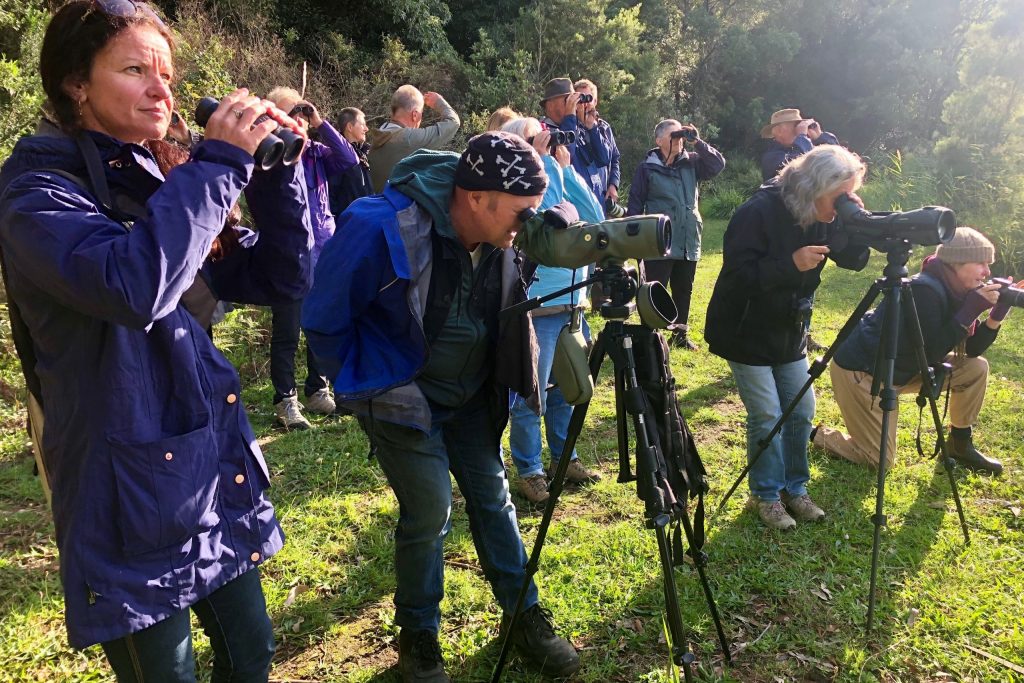
Birds of a feather flocked together recently as the East Gippsland Catchment Management Authority, together with Birdlife East Gippsland, enjoyed breakfast with the birds.
It was a perfect morning for bird watching as the group travelled to Marlo, Loch End and Lake Wat Wat in search of feathered friends. And they were not disappointed, spotting small terns, Australasian shovelers and a rare sighting of Black-Tailed godwits.
Participants also learned about the impact that the Snowy River Rehabilitation project has had on the health of the river system and the wildlife that call it home.

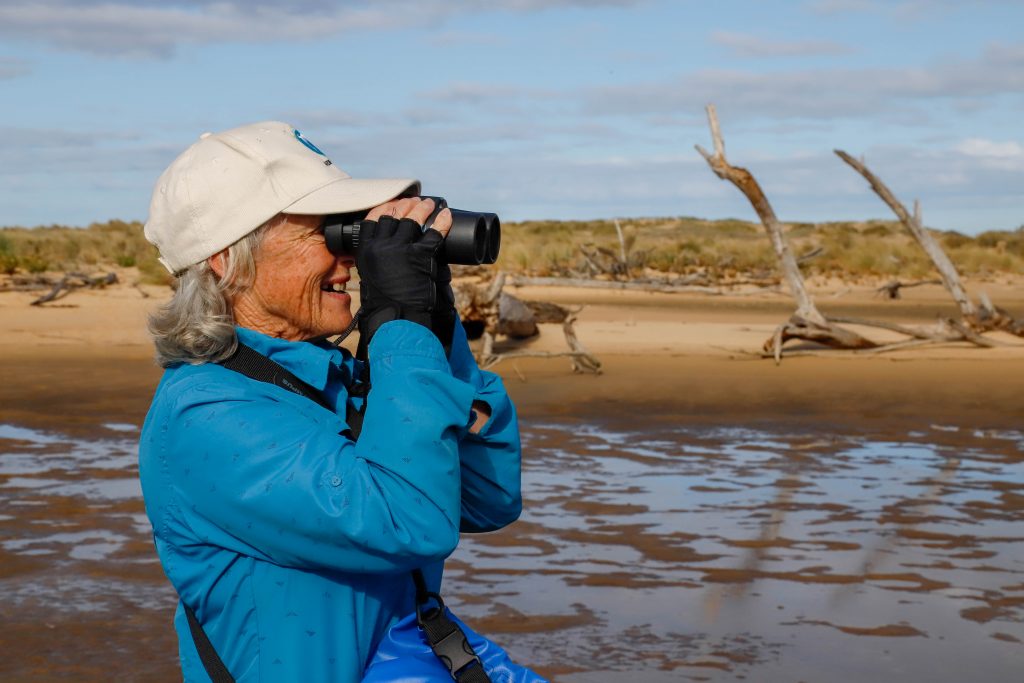
In conjunction with Birdlife Australia, we’d like to invite you to Breakfast with the Birds on Saturday 14th March.
“We have spent over a decade working with landholders and our partners to improve the condition of the Snowy for our community and our wildlife to enjoy, and we want to show it off,” EGCMA Project Coordinator, Mel Birleson said.
“Both locals and visitors appreciate the many birds found along the Snowy and Breakfast with the Birds is a great opportunity to see why birds are important.”
Len Axen from Birdlife East Gippsland, and Deb Sullivan, BirdLife Australia Project Officer, will be on hand to discuss how the Snowy and adjacent wetlands support species such as the endangered Australasian Bittern and Little Bittern.
“Len is an awesome presenter and passionate about his birds. It will be great to have him sharing his knowledge.” Said Ms Birleson.
Breakfast with the Birds will be held on Saturday 14th March from 7am to 10am.
Participants will meet at Forest Park in Orbost and travel by bus stopping at multiple sites to view the bird life before heading back to Orbost for a light breakfast.
“Just bring your hat, water bottle, reusable coffee cup, binoculars and a camera and we’ll supply the food. In the event of extreme weather, we may have to cancel, but we’ll let you know.”
Breakfast with the birds is free, but registration is essential as places are limited. Click here to RSVP now.
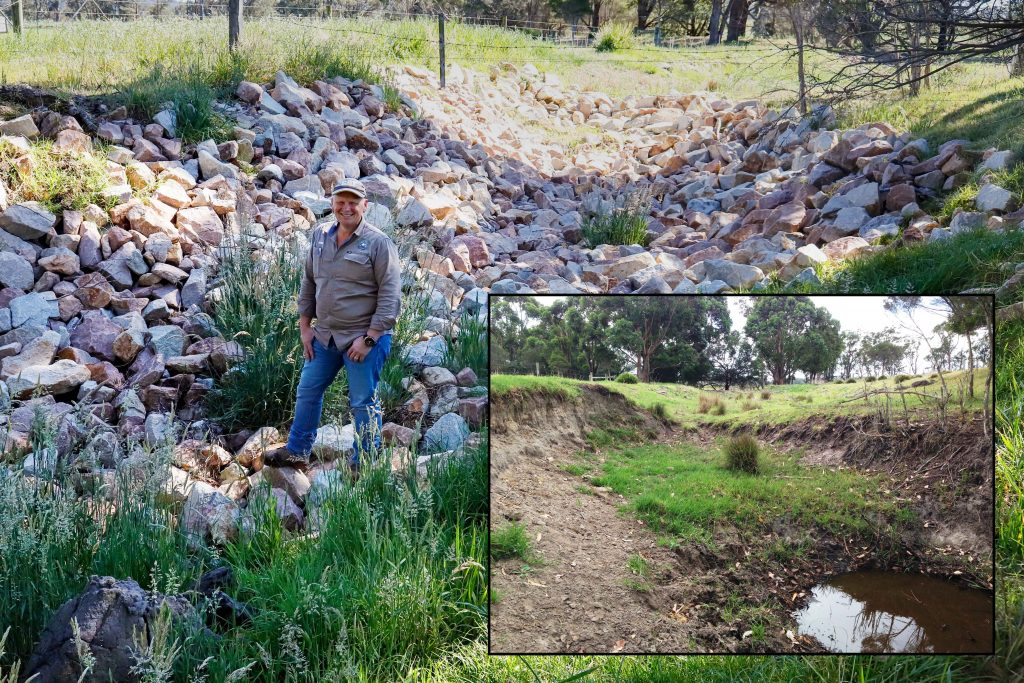
The East Gippsland Catchment Management Authority (EGCMA) has been working with Jarrahmond landholder Mark Johnstone to stabilise a section of Gunns Creek previously eroded by a flood.
“We might currently be in drought, but when it does rain, water can flow fast through these gullies, and that brings the potential to damage our waterways,” said Mr Johnstone. “We knew we had to protect this area or face the potential of further damage.”
With rocks strategically placed, Mark enlisted the support of the Far East Landcare Network and a Victorian Landcare Grant to plant native seedlings.
The 6500 shrubs and grasses will provide food and habitat for critters, and also help to slow future floodwaters before they get into the channel country.
“It was a great collaborative effort,” said Mr Johnstone. “We had 22 students from the Alpine Coastal School, they arrived and immediately just got stuck into planting 1200 seedlings, a fantastic effort.”
“We followed up the next weekend with Landcare and community members volunteering their time to plant the rest. It’s nice to know that people will get behind these projects if you put it out there, people are willing to help.”
“The State Governments ‘Water Plan for Victoria’ recognises that getting people involved in our waterways is good for our health and wellbeing,” said Graeme Dear, EGCMA CEO. “This project will improve the condition of Gunns Creek and is a great example of our communities getting stuff done.”
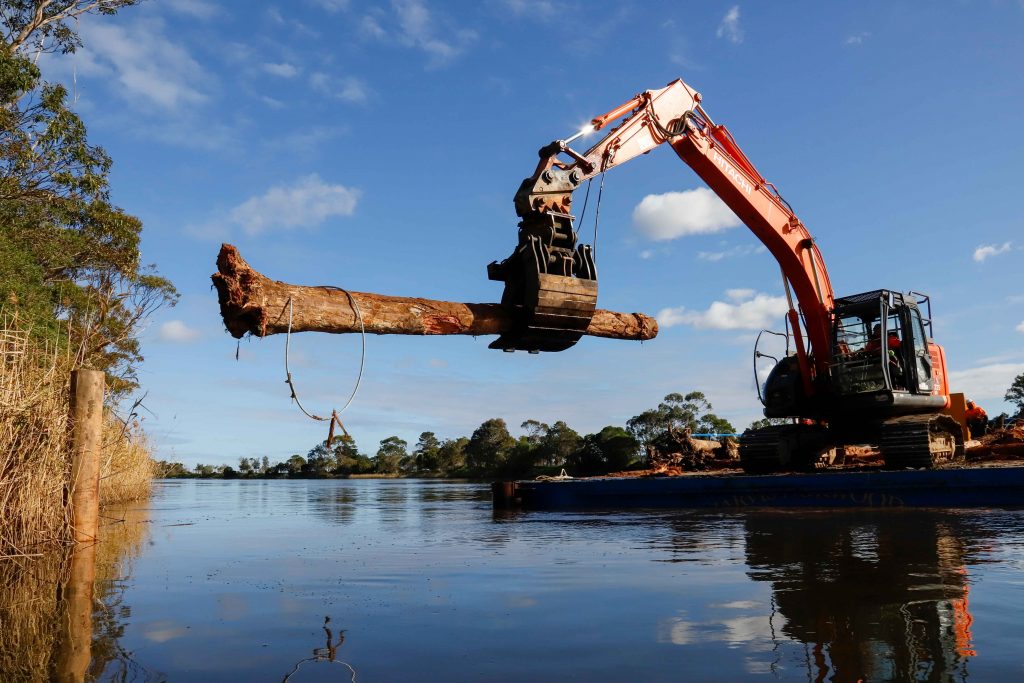
The East Gippsland Catchment Management Authority has been working with local contractors to install twenty-five large wooden structures as habitat for fish and the small critters they feed on.
Funded through the State Governments recreational fishing licences fund, the structures are created from tethering logs with rootballs to a pile driven into the bed of the river from a barge. This minimises disturbance and damage to the adjoining riverbanks.
The structures create shelter and resting spots for key recreational angling species such as Australian Bass, Bream, Luderick and Estuary Perch, and provide refuge from predators.
“Large numbers of snags provide shelter and habitat for fish and the food they prey on”, said Graeme Dear, CEO of the EGCMA. “This project not only benefits the health of the Snowy estuary, but also recreational fishing and tourism for the region.”
Graeme said “ Marlo Angling Club has been actively involved over the years to help prioritise works and promote the benefits of a healthy river to fisherman and the broader community. We would like to thank them for their continued support.”
The EGCMA are working in partnership with DELWP and VicRoads to utilise suitable logs removed for roadworks to help improve our waterways.
The sun was shining and conditions were calm as the East Gippsland Catchment Management Authority (EGCMA), Gunaikurnai Land and Waters Aboriginal Corporation (GLaWAC) and Parks Victoria hosted a walk, talk and paddle at Corringle Foreshore Reserve last week.
Participants learnt about the joint management arrangements between GLaWAC and Parks Victoria, the cultural significance of the Reserve and the importance that environmental water flows play to the health of the Snowy River.
“Getting out into nature is good for the health and wellbeing of our whole community” said Nicole Thompson EGCMA Water Program Team Leader, “We’d like to thank our partners and all of the community members who helped make this day such a success. Getting people involved in our waterways is a key priority in the Water Plan for Victoria.”

The East Gippsland Catchment Management Authority is offering community members an opportunity to explore the Corringle Foreshore Reserve.
The EGCMA, in partnership with the GunaiKurnai Land and Waters Aboriginal Corporation (GLaWAC) and Parks Victoria, will host a free cultural walk, talk and paddle tour at 10.30am on Thursday 30th May.
Participants will have an opportunity to walk through the Foreshore Reserve and adjoining coastline, learn about the significance of Corringle to the Gunaikurnai people and hear from GLaWAC and Parks Victoria about their joint management arrangements.
Taking to the water, participants will paddle toward the mouth of the Snowy River Estuary to learn about the importance that environmental water flows play to the health of the river system, the surrounding biodiversity and the people who enjoy it.
Lunch and all equipment will be supplied and guests will paddle with the support and guidance of qualified and experienced recreational instructors.
The excursion is suitable for people with no prior paddling experience, but participants need to be reasonably fit and agile to enter the canoes or rafts and complete a 2km walk. It’s open to everyone over the age of twelve, and those under 18 must be accompanied by a supervising adult.
Participants will be required to bring clothing and any personal supplies, and be prepared to get a little wet.
If you would like to join in the fun, please register here from Wednesday 15th May. Numbers will be limited so early booking is advisable.
Please note that this paddle is subject to weather conditions and river flows.
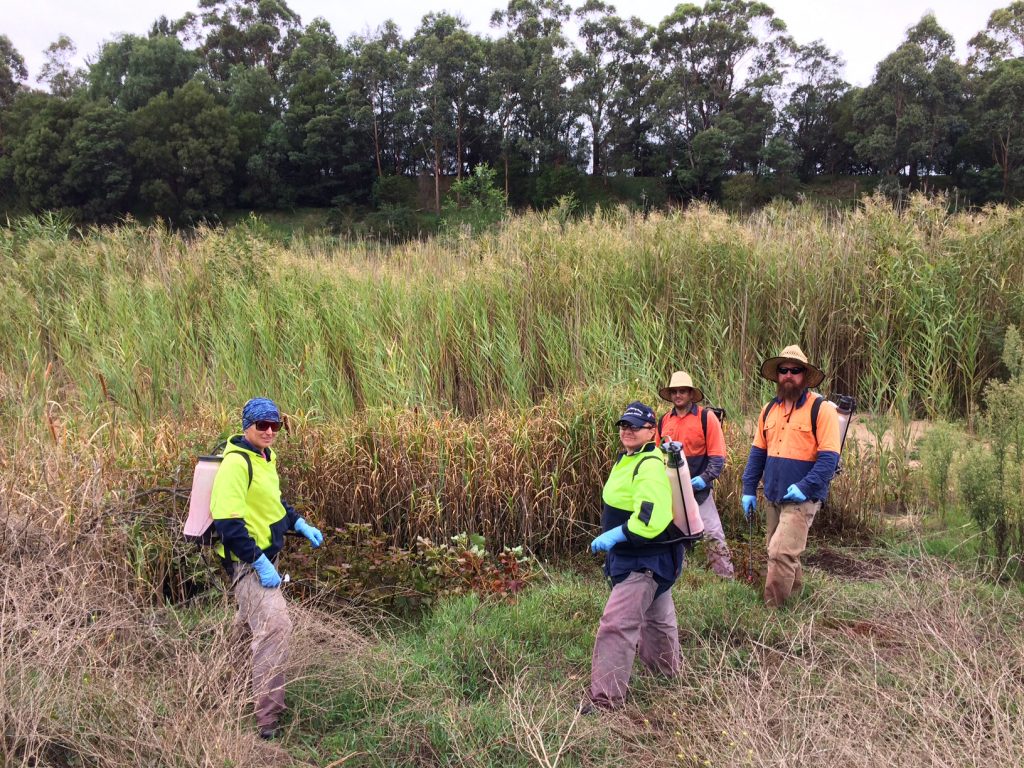
The lower Snowy River work is continuing this year with an ongoing partnership between the East Gippsland Catchment Management Authority (EGCMA) and Moogji Aboriginal Council.
The Moogji works crew have been working on the river for over a decade and look after the area from Jarrahmond to the Brodribb. The crew controls weeds and plants native seedlings to improve the health of the Snowy.
“Moogji are a terrific partner providing opportunities for local people to develop a career path and further employment opportunities while improving the health of the river.” said EGCMA CEO, Graeme Dear.
This aligns with the objectives of the Water Plan for Victoria which seeks greater involvement of indigenous people in waterway management.

The Marlo Angling Club played host to local community members last Monday as Dan Stoessel from the Arthur Rylah Institute (ARI) presented his study – Snowy River, Then & Now.
The study, commissioned by the East Gippsland Catchment Management Authority and funded through the State Government’s environmental water program, sought to understand the changes to the river system over the last one hundred years.
The audience heard about what those changes mean for the health of the river and for the communities who rely on it. There was good discussion about the natural processes of the catchment, the impacts of climate change and the recruitment of native fish populations within the estuary.
“Undertaking these studies helps us gather information around the processes happening within the river system” said Bec Hemming, Programs Manager at the EGCMA. “ARI’s work helps us and the community understand the changing face of the catchment and provides an insight to better target future works by the EGCMA together with our partner agencies, the community and Landholders.”
Graeme Dear, CEO of the EGCMA said, “The Water Plan for Victoria seeks involvement from communities to improve our rivers. This forum is a great example of people and groups working together.”

The iconic Snowy River is home to a diverse range of native fish, birds and plant species. With its stunning scenic landscapes it offers spectacular canoeing and rafting opportunities. It also has significant indigenous cultural heritage sites and rich fertile river flats used for farming.
With 100 acres of Snowy River frontage Robert “Biddy” Russell saw the benefit of trying to do something to reduce the impact of reduced flows and previous land management practices, done in good faith at the time. Together with landholders, extensive work over many years has been conducted by the East Gippsland Catchment Management Authority (EGCMA) and its predecessor, the Snowy River Improvement Trust.
Initial work included fencing off stock access to the river and willow removal. This was followed by planting of a variety of native species from small tussocks to much larger trees which, once established, help protect the banks. “Although I do believe that just fencing the river and letting it go it would eventually heal itself, I just think it would have taken a lot longer.” Biddy said. “The fencing off is really important as the banks were pretty raw with sand. Every time the cows went to the river they would take a couple of hooves full of sand, pushing it into the river.” He added.
Biddy said “As much as I have done this work on my property to protect my land, I also love that the birds are back; the little birds, the waders that disappeared for years, as well as the magnificent sea eagles that nest and feed on my property. The corridor of trees I’ve planted links up to the natural bush and offers them a place to shelter, nest and feed but it also offers shelter for my cows and maybe a buffer for potential big flood waters. There is a real balance and I think it’s a good balance.”
Graeme Dear, EGCMA CEO said. “The long term commitment to the rehabilitation of the Snowy River from the Victorian government includes projects implemented by government agencies, community groups and landholders. By everyone working together over a long time, we have seen very positive changes to the river.”
The work that Biddy has undertaken on his property hasn’t suffered any major flood event which has helped it become the well established vegetation it is today. “It would be unrealistic to believe that in a major flood no damage would occur. It is the lesser damage during minor floods, the return of the native birds and the improvement of the river health that inspires me to continue.”
Biddy will continue to work with the EGCMA, noting that “Staying on top of weeds is very important and I’d like to see more planting in some areas where it’s not as thick with vegetation. It’s my belief that the work that has been done is a positive thing and the river is recovering. I think the river is in good nick actually. ”


